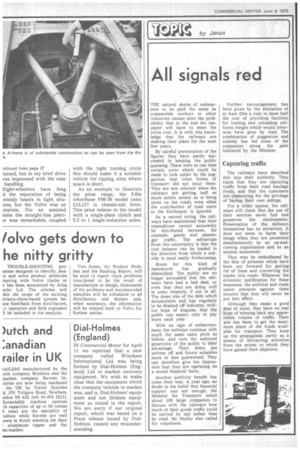All signals red
Page 30

If you've noticed an error in this article please click here to report it so we can fix it.
THE natural desire of railwaymen to be paid the same as comparable workers in other industries cannot alter the probability that in the end the taxpayer will have to meet the extra cost. It is with this knowledge that the railways are making their plans for the next few years.
By careful presentation of the figures they have partly succeeded in keeping the public guessing. There were at one time certain costs which could be made to look unfair by the suggestion that other forms of transport did not incur them. They are less relevant when the railways are getting half as much public money as is being snent on the roads, even when the contribution of road users to the Exchequer is ignored.
As a second string, the railways have maintained that their expenditure cannot accurately be distributed between, for example, goods and passenger traffic. The advantage from this uncertainty is that the cost balance can be loaded in the direction from which a subsidy is most easily forthcoming.
Room for this kind of manoeuvre has gradually diminished. The public are no longer persuaded that the railways have had a bad deal, or even that they are doing well in some respects, if not in all. The sheer size of the debt which accumulates and has regularly to be drained off indicates, without hope of disguise, that the public can expect only to pay more each year.
With no sign of embarrassment the railways continue with much the same sales pitch as before, and turn the enforced generosity of the public to their advantage. Their debts are written off and future subsidies more or less guaranteed. They can therefore give the impression that they are operating on a sound financial basis.
Another publicity benefit has come their way. A year ago, no doubt in the belief that financial support was not enough, the Minister for Transport asked about 100 large companies to discuss with the railways how much of their goods traffic could be carried by rail rather than by road. Mr Mulley also called for volunteers.
Further encouragement has been given by the allocation of at least E5m a year to meet half the cost of providing facilities for loading and unloading railborne freight which would otherwise have gone by road. The combination of suggestion and subsidy has led some of the companies along the path indicated by the Minister.
Capturing traffic
The railways have absorbed this into their publicity. They claim that they are capturing traffic from their road haulage rivals, and that the customers are clamouring for the privilege of having their own sidings.
For a wider appeal, the railways still claim that the use of their services saves fuel and preserves the environment. Preservation of the railways themselves has an attraction. It does not seem to harm their image when they are presented simultaneously as an up-andcoming organisation and as an ancient monument.
They may be emboldened by the fate of schemes which have been put forward for getting rid of them and converting the tracks into roads. Whatever the economic justification for these measures, the political and trade union pressure against them ensures that they will never be put into effect.
Although they make a good deal of noise, they have no real hope of winning back any appreciable volume of traffic. Their aim has been to get the maximum share of the funds available for transport. They keep up the propaganda partly as a means of distracting attention from the extent to which they have gained their objective.


















































































































